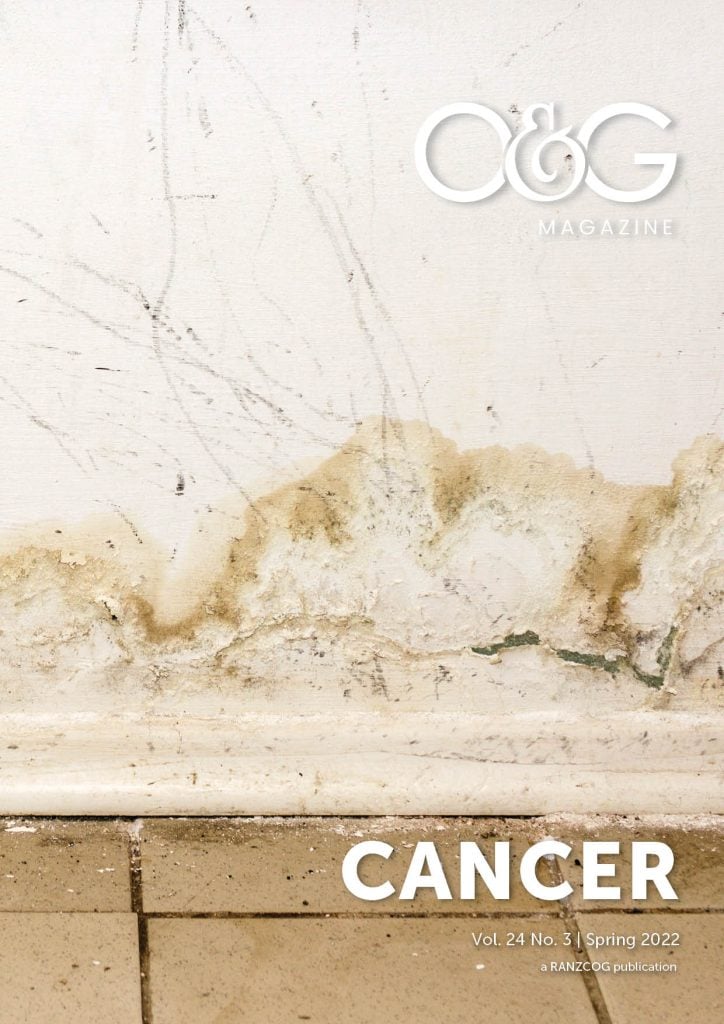Uterine cancer is the fifth most common cancer in Australian women and the most common gynaecological malignancy, with women having a 1 in 44 (2.3%) risk of uterine cancer by age 85.1 Coinciding with rising obesity rates, the incidence of endometrial cancer continues to increase. The majority of women are diagnosed with early-stage disease and surgically managed, with an excellent overall five-year survival rate of 85%.1 The outcome for women with advanced-stage or recurrent disease, however, is poor with only a 17% five-year overall survival if distant disease is present.2
When women are diagnosed with endometrial cancer, risk stratification for recurrent disease currently relies on an assessment of stage, grade and histopathological subtype. Higher stage, higher grade and histopathological subtypes of serous and clear cell carcinomas are associated with poorer prognosis. It is known that the majority (~80%) of women with early-stage endometrial cancer have a good prognosis (95% five-year overall survival), whereas the remaining 20% have at least one risk factor (high-risk histological subtype, higher grade, deep myometrial invasion, lymphovascular space invasion) which is associated with worse prognosis.3 The challenge for clinicians is determining which patients with early-stage endometrial cancer truly have low-risk disease, and subsequently a low risk of recurrence, versus high-risk disease. Low-risk disease can generally be managed with surgery alone whereas it is recommended that high-risk disease is managed with surgery followed by adjuvant therapy (radiotherapy and/or chemotherapy).4
| Molecular subtype | % of endometrial cancers | Prognosis |
| POLEmut | ~10% | Favourable |
| NSMP | ~50% | Intermediate |
| dMMR | 25–30% | Intermediate |
| p53abn | 15% | Poor |
In 2013, The Cancer Genome Atlas (TCGA) published a comprehensive genomic and proteomic analysis of the different endometrial cancer histopathological subtypes. This led to the identification of four distinct molecular subgroups of endometrial cancer with distinct prognostic outcomes.5 The identification of these molecular subgroups, enabled an objective and reproducible classification system, not relying purely on histological subtype, stage and grade and thus eliminating the issue of reproducibility/inter-observer variation between pathologists. However, due to cost and time constraints, the TCGA classification was not suitable for routine clinical use and so different molecular classification tools using surrogate markers with prognostic signatures consistent with the TCGA subgroups have been explored and validated.
In 2017, the ProMisE classification (Proactive Molecular Risk Classifier for Endometrial Cancer) was introduced.
The ProMisE classification identifies four prognostic molecular subgroups: dMMR (mismatch repair deficient), POLE mutation (DNA polymerase epsilon), p53 abnormal (p53abn) and p53 wild-type/no specific molecular profile (p53wt/NSMP). Molecular testing can be performed on endometrial curettage samples, prior to definitive surgery and potentially guide management, including the timing and extent of surgery. Furthermore, testing can be performed on formalin-fixed specimens, rather than relying on fresh tissue which is more costly and not as widely available.6
Tumours with a POLE mutation have the most favourable prognosis whilst the p53abn subgroup is associated with the worst prognosis.7 A recent study from the Netherlands and Denmark has shown five-year recurrence rates of surgically staged patients to be 36.7% (p53 abn), 13.4% (dMMR), 42.9% (NSMP/p53 WT) and 0% (POLE mut).8 Irrespective of stage and lymph node status, patients with p53 abn tumours have poor clinical outcomes.9 Kommoss et al10 described patients with a p53abn tumour to generally be older, with a lower BMI, mostly serous histopathology and diagnosed at both a higher stage and grade. Conversely, p53wt/NSMP tumours were generally low-grade, low stage and endometrioid histopathology.11
Given the distinct prognostic outcomes associated with each of the four molecular subgroups numerous studies are underway to assess how this knowledge can be used to guide both surgical as well as adjuvant treatment decisions. For example, given the favourable prognosis for women with POLEmut tumours, studies are attempting to determine whether adjuvant therapy can be reduced or avoided altogether in this patient cohort. In contrast, because women with p53abn endometrial cancers are known to have a poorer prognosis, improved outcomes with combination chemotherapy and pelvic radiation versus pelvic radiation alone have been assessed.12 dMMR endometrial cancers appear to be more susceptible to radiation therapy and appear to have little benefit from chemotherapy.13 Furthermore, molecular profiling in endometrial cancer can identify those who are more likely to respond to immunotherapy (dMMR) and ongoing research is investigating those more likely to respond to progestogens (NSMP).14 dMMR is found in 25–30% of all endometrial cancers and in most cases is due to tumour methylation; however, 10% of dMMR endometrial cancers are associated with Lynch syndrome and if methylation is absent referral for genetic counselling is recommended for formal testing.
The role of lymph node assessment in endometrial cancer (either sentinel lymph node or lymphadenectomy) continues to be debated, with a wide range of practices throughout the world. Each molecular subtype has an associated risk of lymph node metastases: 44.8% of p53 abn, 14.2% POLEmut, 14.9% dMMR and 10.8% p53wt. Knowledge regarding molecular subgroups in endometrial cancer can help guide lymph node assessment for women, particularly those with p53abn tumours.15 There is also scope for molecular profiling in endometrial cancer in assisting decision making regarding fertility-sparing management and what constitutes optimal surveillance following treatment.16
In the era of personalised cancer medicine, molecular classification should be considered for all endometrial cancers and performed routinely in all high-grade tumours particularly when the result will impact treatment decisions.17 For accurate molecular classification, all four of the molecular subtypes must be tested (rather than a single test in isolation), as up to 5% of carcinomas have more than one subtype.18 However, whilst molecular classification does increase the cost associated with pathological testing, and not all countries worldwide will have sufficient resources to perform testing, it has the ability to guide management and improve outcomes for women, and may actually reduce overall healthcare costs by avoiding unnecessary adjuvant treatment.
Our feature articles represent the views of our authors and do not necessarily represent the views of the Royal Australian and New Zealand College of Obstetricians and Gynaecologists (RANZCOG), who publish O&G Magazine. While we make every effort to ensure that the information we share is accurate, we welcome any comments, suggestions or correction of errors in our comments section below, or by emailing the editor at [email protected].
References
- Cancer Australia. Uterine Cancer. 2021. Available from: www.canceraustralia.gov.au/cancer-types/uterine-cancer/statistics
- Jamieson A, Bosse T, McAlpine J. The emerging role of molecular pathology in directing the systemic treatment of endometrial cancer. Ther Adv Med Oncol. 2021;13:1-14
- Jamieson A, Bosse T, McAlpine J. The emerging role of molecular pathology in directing the systemic treatment of endometrial cancer. Ther Adv Med Oncol. 2021;13:1-14
- Jamieson A, Bosse T, McAlpine J. The emerging role of molecular pathology in directing the systemic treatment of endometrial cancer. Ther Adv Med Oncol. 2021;13:1-14
- Levine D. The Cancer Genome Atlas Research Network. Integrated genomic characterisation of endometrial carcinoma. Nature. 2013;497:67-73
- Kommoss A, McConechy MK, Kommoss F, et al. Final validation of the ProMisE molecular classifier for endometrial carcinoma in a large population-based case series. Annals of Oncology. 2018;29:1180-8
- Talhouk A, McConechy M, Leung S, et al. Confirmation of ProMisE: a simple, genomics-based clinical classifier for endometrial cancer. Cancer. 2017;123(5):802-13
- Leon-Castillo A, Horeweg N, Peters E, et al. Prognostic relevance of the molecular classification in high-grade endometrial cancer for patients staged by lymphadenectomy and without adjuvant treatment. Gynecologic Oncology. 2022;164:577-86
- Leon-Castillo A, Horeweg N, Peters E, et al. Prognostic relevance of the molecular classification in high-grade endometrial cancer for patients staged by lymphadenectomy and without adjuvant treatment. Gynecologic Oncology. 2022;164:577-86
- Kommoss A, McConechy MK, Kommoss F, et al. Final validation of the ProMisE molecular classifier for endometrial carcinoma in a large population-based case series. Annals of Oncology. 2018;29:1180-8
- Kommoss A, McConechy MK, Kommoss F, et al. Final validation of the ProMisE molecular classifier for endometrial carcinoma in a large population-based case series. Annals of Oncology. 2018;29:1180-8
- Jamieson A, Bosse T, McAlpine J. The emerging role of molecular pathology in directing the systemic treatment of endometrial cancer. Ther Adv Med Oncol. 2021;13:1-14
- Jamieson A, Bosse T, McAlpine J. The emerging role of molecular pathology in directing the systemic treatment of endometrial cancer. Ther Adv Med Oncol. 2021;13:1-14
- Jamieson A, Bosse T, McAlpine J. The emerging role of molecular pathology in directing the systemic treatment of endometrial cancer. Ther Adv Med Oncol. 2021;13:1-14
- Thompson E, Jamieson A, Huvila J, et al. 223 Endometrial carcinoma molecular subtype correlates with the presence of lymph node metastases. International Journal of Gynecologic Cancer. 2021;31:A81-A82.
- Kommoss A, McConechy MK, Kommoss F, et al. Final validation of the ProMisE molecular classifier for endometrial carcinoma in a large population-based case series. Annals of Oncology. 2018;29:1180-8
- Jamieson A, Bosse T, McAlpine J. The emerging role of molecular pathology in directing the systemic treatment of endometrial cancer. Ther Adv Med Oncol. 2021;13:1-14
- Concin N, Matias-Guiu X, Vergote I, et al. ESGO/ESTRO/ESP guidelines for the management of patients with endometrial carcinoma. International Journal of Gynecologic Cancer. 2021;31:12-39







Leave a Reply